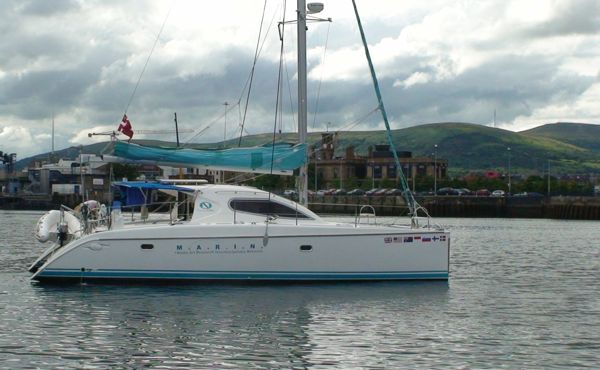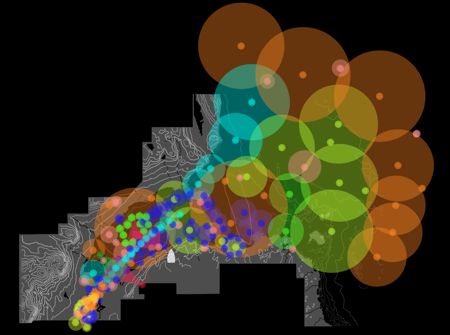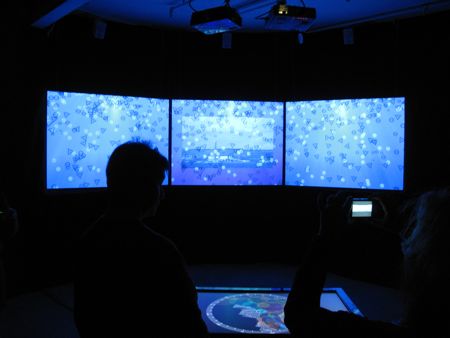M.A.R.I.N. made its debut at ISEA2009 Belfast in August 2009. This first expedition, the “Irish Sea EcoLocated Residency”, focused upon Littoral cultures: how marine ecologies close to human settlements are perceived by scientists and local communities, and how our art & science research team will introduce new cultural strategies to interlace them.

The MARIN vessel in Belfast harbour.
This first collaborative residency aboard the MARIN craft, entitled Ecolocated: Littoral Lives was realized by three artists, Nigel Helyer (AU), Tapio Mäkelä (FI), and Andreas Siagian (ID), supported by additional members of the AudioNomad team, Daniel Woo and Michael Lake from University of North-South Wales, Sydney. The sailing vessel, a 12.6m catamaran was converted into a floating studio/laboratory, serviced by a large array of solar panels (that struggled in the weak Northern sunshine!).

The Firth of Inverness.
One of my ship’s logs ~ these formed part of the first version of “JourneyScapes” and map based log capable of geolocation images, texts and audio and which formed part of the first of two exhibitions at Catalyst in Belfast.
The EcoLocated team conducted water quality tests, made field and hydrophone recordings, interviews, and collected and geo-tagged information to create a location based immersive, surround-sound installation, technically based upon AudioNomad software (developed by Nigel Helyer and Daniel Woo). EcoLocated embraced a new development which took water quality measurements, which were sonified and visualised within an enhanced version of AudioNomad’s Trigger Tiles editing platform, allowing visitors to interact with pools of scientific data, geo-located within the mapping interface.

Entering Inverness harbour.
In addition to collecting hours of oral histories and interviews with Environmental Scientists the EcoLocated project continued to extend beyond the gallery context initiating a range of local community workshops on the North West Coast of the UK and in Liverpool. Stage one of the installation opened at the Catalyst Arts gallery in Belfast on August 6th 2009 with stage two opening for the ISEA symposium which took place between August 23rd and September 1st 2009. The crew subsequently sailed to the West coast of the UK to participate in the AND Festival (Abandon Normal Devices) hosted by FACT (The Foundation for Art and Creative Technology). We moored right outside the Tate North and ran projects with their youth team.

Ben Nevis.

Tapio taking a water quality sample.
We have arrived safe and sound, albeit a little damp after a thirteen day yoyage across the North Sea, though the Caledonian Canal (that bisects Scotland from Inverness to Fort William) and then past the isles of Jura and Islay, across the North Channel to Ulster. Now the work begins!

Belfast Port.

The AudioNomad interface for the Stage 2 Ecolocated exhibition
Catalyst Arts, Belfast ISEA2009.
The following audio snippets are sample files that form the ‘raw material’ of the AudioNomad 3D spatial audio composition ~ better than nothing but the only way to experience the real thing is to experience the real thing!

12.2 surround rig with triple projection showing water quality data visualisation.
Ecolocated_Helyer_log_Outbound Brunsbuttel to Belfast.
And finally some of my ships-log entries from the voyage:
Wednesday 22 July.
Today is a long haul, up at 06h00 at a guest house in London, lugging too much gear on the local bust to Heathrow. Catch up with Mike on the 10h30 flight to Hamburg and then into the momentary confusion of German train world. Three trains and one long bus ride later we are in Brunsbuttel but with scant idea as to the location of the ship. We find the Alter Hafen but the boat location has been changed ~ more confusion ensues. Finally we arrive by taxi dispatched by Tapio to the marina near the Kiel Canal sea lock and meet Lars Dall our skipper and look over our ship ~ “Boogie Woogie” a 11.9 metre catamaran. Overnight at Brunsbuttel.
Thursday 23 July.
We have the morning set aside to wiring up the solar arrays, installing the battery banks and fixing up the wind turbine, our project will require a reliable supply of energy whilst at sea, hence the additional power generation. We depart Brunsbuttel at 14h30 entering the massive Kiel Canal sea lock.
We head West into a choppy grey-brown sea, the coast here is very shallow, formed of sand and mud banks and low lying land forms ~ the ship is under motor into a strong head wind.
We decide to make for Bokum, a small Friesland island on the German/Dutch border, but at our mid point we discuss turning back to Brunsbuttel as the weather is deteriorating, nasty short seas with strong headwinds, the ship is pitching and slamming constantly.
We continue but I succumb to seasickness (first time in 25 years) evoking a mixture of embarrassment and discomfort but the watches must continue.
Friday 24 July.
We are operating a 2 hour on, 4 hour off watch system which is pretty civilised! I take the 00h00 ~ 02h00, Tapio and Mike the 02h00 ~ 04h00, Lars the 04h00 ~ 06h00, I again the 06h00 ~ 08h00, Tapio and Mike the 08h00 ~ 10h00 and Lars the 10h00 ~ 12h00 and so on. We coast Westwards along the Friesland shore, which apart from the extraordinary amount of wind farms is devoid of features.
We arrive in Bokum around 16h00 (a 26 hour transit) and tied up and settle the ship. The hafen has a small restaurant flying an enthusiastic array of national flags and is surrounded by three massive wind turbines which whine like banshees in the stiff breeze.
We are consoled byTea from bone china tea sets and very good Apfelkuchen ~ my stomach feels much happier. Our intentions are to overnight and depart early next morning weather permitting.
Saturday 25 July.
All the crew oversleep to the accompaniment of howling westerly winds. The big catamaran berthed adjacent to us slips his lines and goes to sea only to return an hour later, he has bigger engines than we but is a lighter ship, but could not make any headway.
We revert to plan B, stay in port and work on the boat and the EcoLocated technical set up. The crew manage to stretch their legs and in the evening we visit the Bokum township which is in fiesta mode ~ as usual our objective is to locate internet access and we sit drinking and keying, downloading grim looking wind maps of the North Sea.
Sunday 26 July.
We slip our moorings at 08h30 and head in a Westerly direction for a small harbour on a Dutch Island pending our crossing to England and North West to the Firth of Inverness where we can enter the Caledonian Canal. We sail for a while and discuss if we should simply plot a direct course for Inverness making the more direct, but more exposed diagonal crossing of the North Sea. The winds seem to be turning south and so we decide to take to the high seas! My seasickness persists ~ but then so do the watches!
Monday 27 July.
Out of sight of land and virtually no shipping now that we have left the North German and Dutch coastal lanes. Short grey swell at 2 metres and plenty of sea birds are our only company.
Neptune has taken possession of my body, I canʼt even keep a few Knäckebröd down and cannot stomach going below to my cabin in the Portside hull, so off watch I lie on a couch in the main salon. A fatigue induced delirium sets in ~ I can still force myself to stand my watches but do not have the energy for anything else, even simple thought is a real task.
Tuesday 28 July.
Neptune is still demanding his pound of flesh but I am getting on top of the nausea and can begin to focus again. The solo night watches are have sublime moments with phosphorescence streaming out from the twin transoms and large wracks of rain filled cloud looming over the horizon.
On the midnight to 02h00 watch a serious spate of hand steering as the ship roars dead downwind, sails set Goose-wing and big lumpy breaking rollers piling up from behind pushing her this way and that. Finally we spy the Scottish coastline and follow it northwards keeping a sharp lookout for the coastal and oil-rig traffic centred about Aberdeen.
Mike volunteers to make a pasta and I realise that I am starving and actually want to eat, even though the idea makes me nervous. I manage to keep it down and am glad that the boat motion in the following seas is quite different than the rocking horse effect when going straight into it!
Wednesday 29 July.
We continue to work up the East coast the air is extraordinarily clear, as is the sea. The coastline looks beautiful and dotted with small settlements as we gradually track to the West into the Firth of Inverness where we plan to moor overnight before entering the Caledonian Canal.
We are accompanied by pods of Dolphin up the Firth and finally berth in a small and brand new marina just west of the suspension bridge. The marina has a distinctly Nordic population, our Danish flag fluttering alongside Norwegian and Swedish pennants; there is even a sailing replica of a Norse longship on our jetty, a reminder of the cultural heritage of these islands ~ it is only a two day sail to Norway from here. We re-supply in Inverness and spend the evening on-board preparing work schedules and equipment.
Thursday 30 July.
Off at 09h00 sharp and into the sea lock of the Caledonian Canal where we interview the Lock keeper who is very friendly and informative. The canal system is well organised and very carefully maintained ~ fantastic to experience heritage as a working and functional environment.
We proceed slowly through series of swing bridges, lock gates and wooded canalised waterway sections that finally open into Loch Ness which is an extraordinarily beautiful stretch of deep water bounded by rugged wooded hills ~ this is the beginning of the Great Glen, a natural fault line that bisects Scotland diagonally between Inverness and Fort William.
The crew of course are more interested in the virtual world, Tapio and Mike (and even the skipper Lars) are below, on-line ~ I am the analogue boy preferring to handwrite and draw up on deck.
Dreaming of sighting the Monster and a single malt when we dock this evening! We tie up in Fort Augusta at the Northern end of Loch Ness, no Monster but the single malt is highly possible as the lock sides are lined with comfy bars which we loiter in too long and miss dinner ~ having to make do with fish and chips!
Friday 31 July.
Before we slip our moorings Tapio and I take off in the rubber dinghy into Loch Ness to take water quality samples and some hydrophone recordings ~ as ever I manage to record ship prop noise but nothing biological certainly no Monster! There is however a forestry helicopter dusting the Larch forest with something probably not organic and two RAF fighters screaming down the Glen at treetop level. We spend the day cruising through locks and canal sections ending just shy of Fort William and the final series of locks that descend to the open water.
Lars stays aboard for the evening but the rest of us take a taxi to the Glen Finnan House Hotel for an evening of traditional music. A classic old Scottish house with a great atmosphere but we again arrive too late to eat and so survive the evening on alcohol and peanuts!
Saturday 1 August.
We leave our berth and head for “Neptune’s Ladder” a series of eight locks that take us to the Sea Lock and out to the Firth. “Boogie Woogie” is a big vessel, 11.9 metres long and 6.7 metres wide, sitting high in the water and so attracts a good deal of attention from the tourists who track our relatively slow progress through the serial locks. We walk the big boat along the lock-side paths, leading her like a horse on a halter, and holding her as the water falls and gates swing open.
Once we have cleared the final Sea Lock we cruise down the Firth heading for Oban and watching for the foul weather that has been forecast. Predictably it arrives, heavy grey rain wrapped in a cold wind, Ben Nevis has its peak shrouded in low cloud moody as a pagan God.
All hands to the keyboards below as the ship once again turns into a typing pool, The robot ship running on auto-pilot, blindly forging out to sea, deaf dumb and blind but with a great sense of direction! We arrive in a marina nestled behind a fortified Manse, some 3 nautical miles North of Oban and head for the Restaurant ~ finally we are in time to eat!
Sunday 2 August.
My bunk in the port hull straddles a large Volvo-Penta diesel engine which doubles as a very effective alarm clock! The foul weather that we had anticipated has not arrived and we depart our berth early heading into a calm sea and light winds to cruise towards the North Channel past the islands of Jura and Islay (where the good single malts come from) and onto the Mull of Kintyre.
The winds freshen and swing Westerly so the sails go up and we are ploughing along at 8 to 9 knots in flat water between the islands, just as we pass the last of the Scottish Islands a medium size whale surfaces 50 metres in front of the ship but we are both moving fast and avoid contact, the whale surfaces again on the starboard beam and then quarter before sounding into the Firth which reads as 147 metres deep – I yell below to the rest of the crew only to hear the response “yeah – i saw a fox swimming past yesterday!” Ahead the outline of the Ulster coast materialises.
The Midnight watch is pitch black and freezing cold, following the distant lights on the Irish coast, no shipping to be seen except one small fishing boat. We are close to port now so I remain on deck and we berth in Carrickfergus at 03h00.
Monday 3 August.
Another early morning departure into the mists of the Belfast Loch. We remain in Radio contact with the Belfast Harbour Master as we drive up the Fairway counting up the beacons into the commercial port. We all struggle to catch his drift ~ a mixture of Irish brogue and static. The port is full of beaten up cargo ships and RoRoʼs, cranes and old industrial sites. We come to the head of the Loch and into the Lagan river to find our berth alongside the new Odyssey centre ~ this will be our working base for the next few weeks.
etc etc.